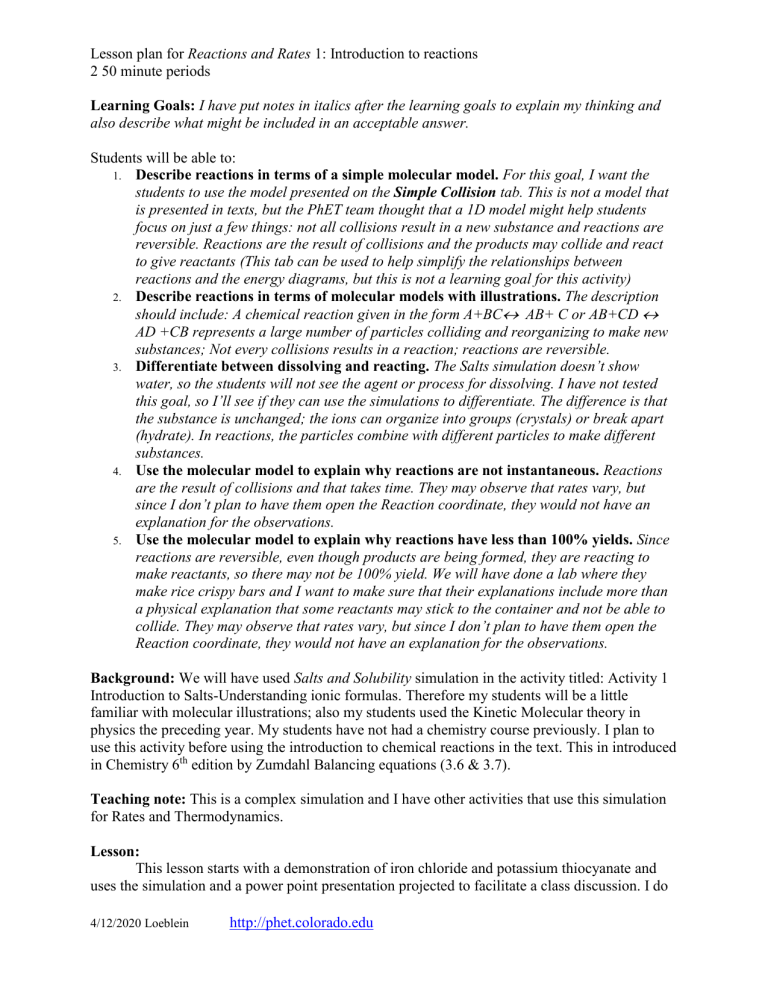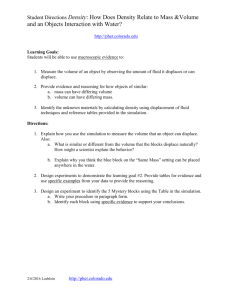1 Lesson plan reactions and rate introduction to reactions (1)

Lesson plan for Reactions and Rates 1: Introduction to reactions
2 50 minute periods
Learning Goals: I have put notes in italics after the learning goals to explain my thinking and also describe what might be included in an acceptable answer.
Students will be able to:
1.
Describe reactions in terms of a simple molecular model.
For this goal, I want the students to use the model presented on the Simple Collision tab. This is not a model that is presented in texts, but the PhET team thought that a 1D model might help students focus on just a few things: not all collisions result in a new substance and reactions are
2.
3.
reversible. Reactions are the result of collisions and the products may collide and react to give reactants (This tab can be used to help simplify the relationships between reactions and the energy diagrams, but this is not a learning goal for this activity)
Describe reactions in terms of molecular models with illustrations.
The description should include: A chemical reaction given in the form A+BC
AB+ C or AB+CD
AD +CB represents a large number of particles colliding and reorganizing to make new substances; Not every collisions results in a reaction; reactions are reversible.
Differentiate between dissolving and reacting.
The Salts simulation doesn’t show
4.
5.
water, so the students will not see the agent or process for dissolving. I have not tested this goal, so I’ll see if they can use the simulations to differentiate. The difference is that the substance is unchanged; the ions can organize into groups (crystals) or break apart
(hydrate). In reactions, the particles combine with different particles to make different substances.
Use the molecular model to explain why reactions are not instantaneous. Reactions are the result of collisions and that takes time. They may observe that rates vary, but since I don’t plan to have them open the Reaction coordinate, they would not have an explanation for the observations.
Use the molecular model to explain why reactions have less than 100% yields. Since reactions are reversible, even though products are being formed, they are reacting to make reactants, so there may not be 100% yield. We will have done a lab where they make rice crispy bars and I want to make sure that their explanations include more than a physical explanation that some reactants may stick to the container and not be able to collide. They may observe that rates vary, but since I don’t plan to have them open the
Reaction coordinate, they would not have an explanation for the observations.
Background: We will have used Salts and Solubility simulation in the activity titled: Activity 1
Introduction to Salts-Understanding ionic formulas. Therefore my students will be a little familiar with molecular illustrations; also my students used the Kinetic Molecular theory in physics the preceding year. My students have not had a chemistry course previously. I plan to use this activity before using the introduction to chemical reactions in the text. This in introduced in Chemistry 6 th
edition by Zumdahl Balancing equations (3.6 & 3.7).
Teaching note: This is a complex simulation and I have other activities that use this simulation for Rates and Thermodynamics.
Lesson:
This lesson starts with a demonstration of iron chloride and potassium thiocyanate and uses the simulation and a power point presentation projected to facilitate a class discussion. I do
4/12/2020 Loeblein http://phet.colorado.edu
Lesson plan for Reactions and Rates 1: Introduction to reactions
2 50 minute periods not plan to give them the reaction, but just say chemical 1 mixes with chemical 2. I am not concerned that this is a complicated reaction; I just wanted to use one that had only color change.
I would have enough prepared to repeat the experiment; I usually mix them at least twice. Large test tubes work nicely for a vessel in my classroom, which has only 30 students.
Then the students will use the simulation in an inquiry activity to complete the learning goals. My students use a computer lab and work in pairs. On #1 of the directions, I will ask them to make their drawings by hand because I have found that if they use the computer, the step takes too much class time.
Postlesson: I plan to use Magnesium reacting with hydrochloric acid as another demonstration of a reaction and this time use a proper balanced equation. I will also have some salts, white and colored, in solid form and in solution to mix with water. One thing that my students have difficulty with is recognizing dilution color change vs chemical color change. There are some slides included for the post-lesson.
4/12/2020 Loeblein http://phet.colorado.edu


